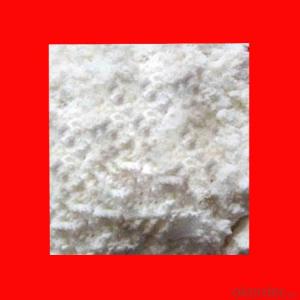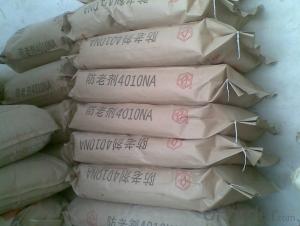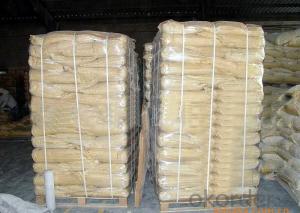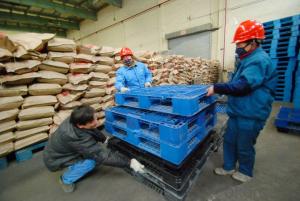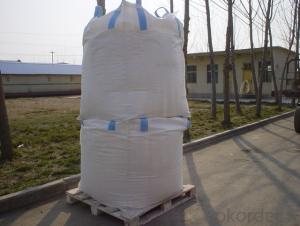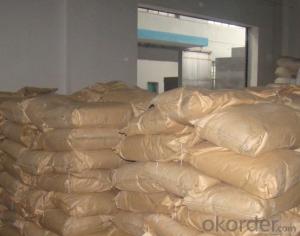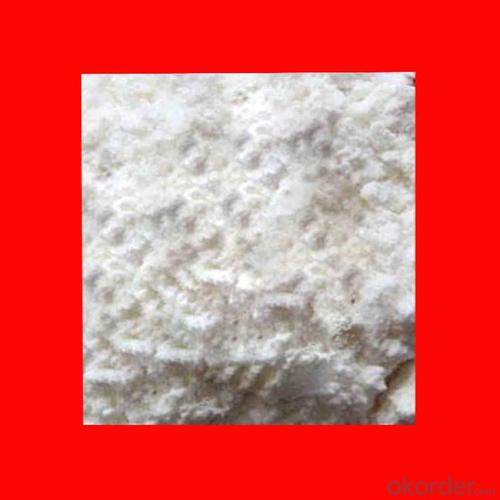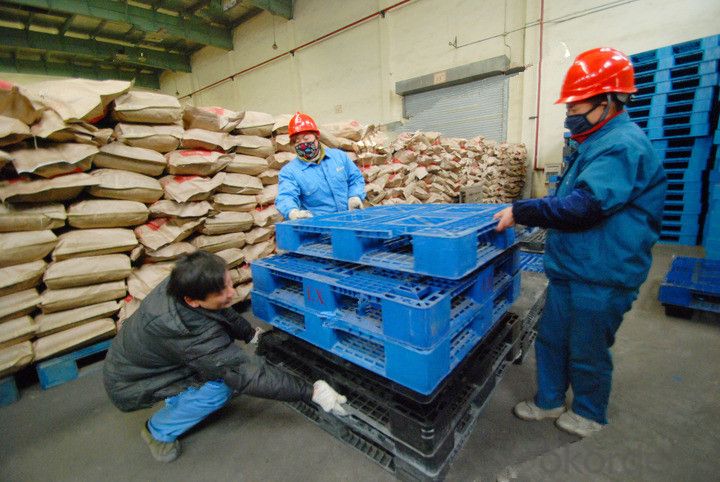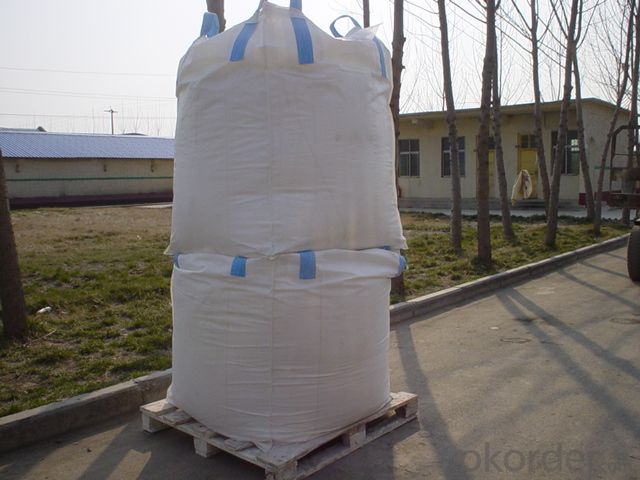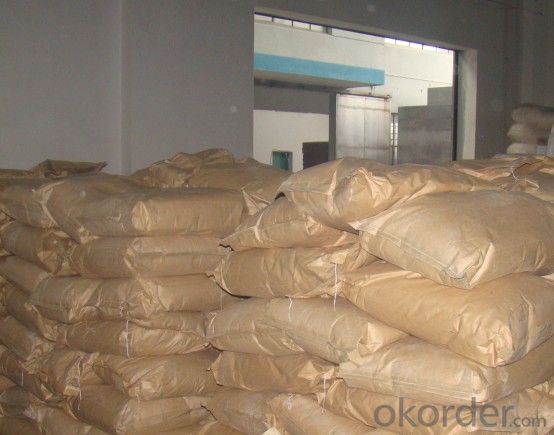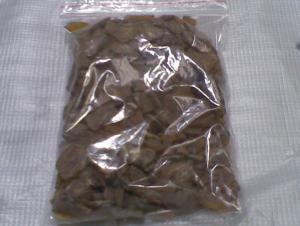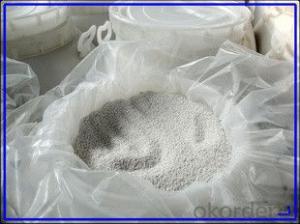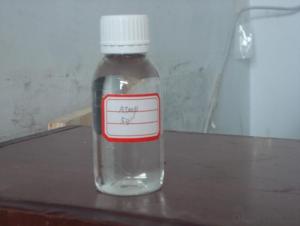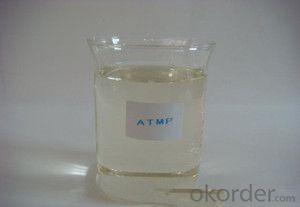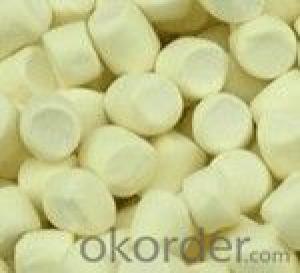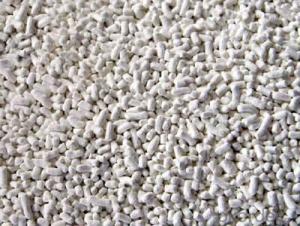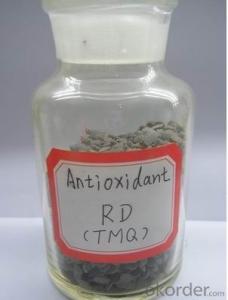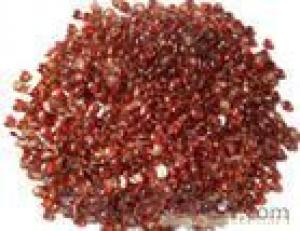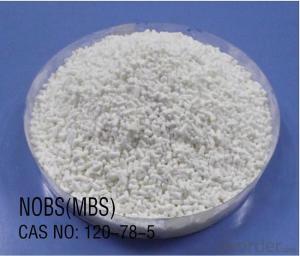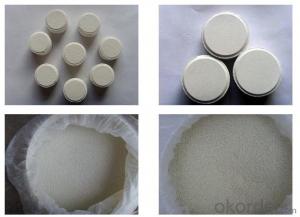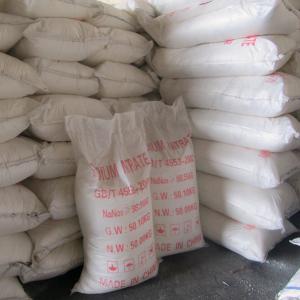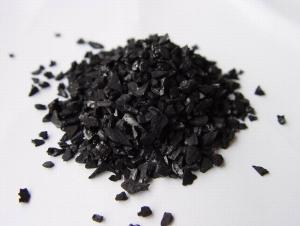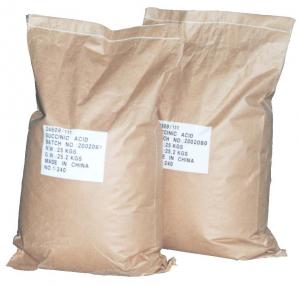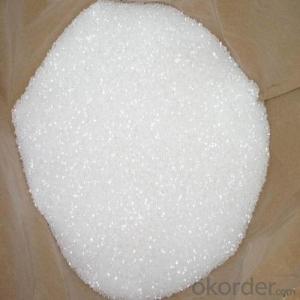Rubber Chemcials Rubber Antioxidant MODEL MB
- Loading Port:
- Tianjin
- Payment Terms:
- TT OR LC
- Min Order Qty:
- 25 m.t.
- Supply Capability:
- 12000 m.t./month
OKorder Service Pledge
OKorder Financial Service
You Might Also Like
MB
Chemical Name:2- Mercaptobenzimidazole
Molecular Formula:C 7 H 6 N 2 S
Molecular Weight:150.2
CAS No.:583-39-1
Specifications:
Item | Specifications | ||
High Grade | 1st Grade | Qualified | |
Appearance | Light-yellow or white Power crystals (Granules) | ||
Initial Melting Point°C Min. | 295.0 | 290.0 | 285.0 |
Heat Loss, % Max. | 0.30 | 0.40 | 0.50 |
Ash, % Max. | 0.30 | 0.40 | 0.50 |
Residue on 150 µm Sieve % Max. | 0.30 | 0.40 | 0.50 |
Properties: Light-yellow or white Power crystals, bitterness, relative density is 1.42 ± 0.02g/cm3 , soluble in alcohol, acetone and ethyl acetate, difficully soluble in gasoline petrol and dichloromethane, insoluble in carbon tetrachloride, benzene and water, non-toxic.
Applications: Antioxidant MB can effectively protect the pollution of copper and deal with the bad effect of over-vulcanization. It has an acation of delay to the accelerator M, DM, TMTD, etc. There are better actions when it is used with antioxident . Change less in color, it can be used in wire, cable and transparent or color rubber products and it also can be used as heat stabilizer of polyethylene and polypropylene.
Packing: Coextruded paper bags lined with polyethylene film bags. Net weight 25 kg per bag.
Storage: Store closed containers in a cool, dry, well-ventilated area. Avoid exposure to direct sunlight.
- Q: Why the catalyst after the chemical reaction of its quality and chemical properties unchanged
- The catalyst is only a catalytic role, not directly involved in the reaction, the current principle of its role is not clear
- Q: Co and No form a chemical equation for Co2 and No2 under the action of a catalyst
- 2CO + 2NO == N2 + 2CO2
- Q: Also, how is the catalyst affected by heat? Please answer all of the questions not just one of the three. THANK YOU!
- It denatures the catalyst because the rise in pH or amount of H3O+ ions. Temperature will also denature the catalyst if it's out of its optimum range.
- Q: Why are catalysts so effective in small amounts?
- Catalysts don't get used up in reactions. Because of this, a single catalyst molecule can function again and again. Some catalysts are better than others for a given reaction. More effective catalysts reduce the time taken for 1/ the rate of travel of the molecule to the active site, 2/ the time the reaction takes, or 3/ the time it takes for products to diffuse away, or 4/ a combination of the above. The more effective a catalyst is in these factors, the less is needed to make it equally effective.
- Q: Is it possible for the different chemical reactions to have the same catalyst?
- Right, think about the catalysis of biological enzymes
- Q: My chemistry teacher wont tell me because it's in the higher course. And i'm not waiting a whole year to find out. And also, google is being a gimp about it. So thanks a lot if you know, I only have basic chemistry knowledge btw, lumen'ss terms if you can.
- MAD = Mutual certain Destruction you could injury us, of direction. yet you could no longer injury us till now we, even from the grave injury you too. we can be lifeless, we understand that. yet you will no longer stay to confirm and revel in it. what would be left of the two one human beings will ought to combat the subsequent war with sticks and stones. 3 skill of dropping the bomb: by skill of airplane, by skill of submarine launch and by skill of ICBM Inter Continental Ballistic Missile. As the two events found out war exchange into certain destruction, neither fairly needed that. We have been given fairly near to nuclear war, exceedingly throughout the Cuba disaster. yet provided that a nuclear war might propose the certain finished destruction of and the U.S. and the u . s . and West + East Europe, it must be prevented. in assessment to on the instant. have been non secular fans already have the bomb (Pakistan) or very near to construct one (Iran) and don't care a rattling concerning the outcomes. Allah will supply! (them with seventy two virgins each and each)
- Q: Can manganese dioxide be used as a catalyst for various chemical reactions?
- Catalyst in the reaction process involved in the reaction, after the completion of the reaction was reduced to the original ingredients.For example: heating decomposition of potassium permanganate when added potassium permanganate potassium potassium permanganate decomposition process, the potassium permanganate is involved in the reaction, The specific way is not clear.Finally, the occurrence of potassium permanganate before and after the reaction of the catalyst changes in morphology, particles into powder, powder particles and so on.
- Q: Does anybody have any tips or references I can go to for this? I'm writing a novel and the main character wants to be a catalyst; the story isn't about him and his journey, so much as the effects on everyone around him that come about simply because of him being there and being who he is. How would I go about doing this, and doing it well?
- Ways to be a catalyst: By his behaviour: - He is a good listener. People use him as a sounding board and make important decisions as a result. - He is indiscreet and inadvertently reveals people's secrets and back-sniping comments. - He is a ****-stirring gossip. - He is a home-wrecking Lothario. - He is wise and gives good advice. - He is a hooligan who ruins businesses with vandalism, costs people their jobs and ruins relationships by beating people up. - He is a manipulative, blackmailing bastard who tries to turn every woman into a prostitute and con every man out of his money. - He is a charlatan who preaches nonsense about religion, health and business investments. By effortlessly influencing other people's behaviour: - He is famous and people try to impress him wherever he goes. - He has cancer or a disabling war wound. People admire and pity him and are shocked by his PTs mood wings. - He is gay, Muslim or a suspected paedophile and people want to persecute or cure him. - He is destitute. People argue amongst themselves over whether it's because he's lazy, has bad karma or there but for the grace of God go I. - He really looks like Jesus, Buddha or Santa and the sight of him makes people contemplate their Humanist values, coming to various conclusions. Perhaps you can write about his reputation; how he earned it, how it precedes him and provokes prejudices that he sometimes confirms or disproves. Use a detached, omniscient God-narrator. (Pretend Morgan Freeman's reading the audiobook.) Alternatively perhaps he is not a catalyst but a neurotic voyeur, fascinated by the minutiae of other people's lives so that the mundane appears tumultuous. He is not influencing people but your account of the changes in people's lives are centred on his observation of them.
- Q: A substance involved in chemical reflection, but reflects the quality of the material before and after the change, you say it is a catalyst?
- Is a catalyst. Principle and burning black copper wire and ethanol reaction to produce acetaldehyde the same
- Q: how a catalyst can provide a new route in forming the product?
- A catalyst may provide a new route in forming a product. Often the reactants have too much energy and bounce off of each other forming few products. The catalyst may provide a surface where the reactants can settle momentarily in close proximity completing the reaction at an increased rate. The catalyst has been pictured (for illustration only) as a surface filled with grooves and when the reactants settle within the grooves (forming a film?) they are close enough to react rather than bounce off of each other. As such the catalyst facilitates the reaction without being used up in the reaction. The catalyst may become 'poisoned' with other molecules that interfere with the desired reaction and the reactants may have to be relatively pure to protect the catalyst.
Send your message to us
Rubber Chemcials Rubber Antioxidant MODEL MB
- Loading Port:
- Tianjin
- Payment Terms:
- TT OR LC
- Min Order Qty:
- 25 m.t.
- Supply Capability:
- 12000 m.t./month
OKorder Service Pledge
OKorder Financial Service
Similar products
Hot products
Hot Searches
Related keywords
